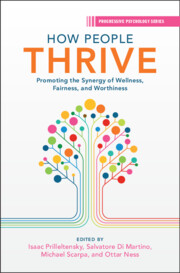Book contents
- How People Thrive
- The Progressive Psychology Book Series
- How People Thrive
- Copyright page
- Contents
- Figures
- Tables
- Contributors
- Chapter 1 Thriving as the Synergy of Wellness, Fairness, and Worthiness
- Chapter 2 Thriving within Ourselves: Epistemic Injustice and Individual Wellness
- Chapter 3 Thriving Families and Friendships
- Chapter 4 Thriving in Context: Wellness, Fairness, and Worthiness in Diverse Groups
- Chapter 5 Thriving Schools: Creating Equitable Thriving within Schools
- Chapter 6 Thriving Workplaces: Wellness, Fairness, and Worthiness at Work
- Chapter 7 Thriving Communities
- Chapter 8 Thriving Societies
- Chapter 9 Thriving World
- Index
- References
Chapter 4 - Thriving in Context: Wellness, Fairness, and Worthiness in Diverse Groups
Published online by Cambridge University Press: 14 November 2024
- How People Thrive
- The Progressive Psychology Book Series
- How People Thrive
- Copyright page
- Contents
- Figures
- Tables
- Contributors
- Chapter 1 Thriving as the Synergy of Wellness, Fairness, and Worthiness
- Chapter 2 Thriving within Ourselves: Epistemic Injustice and Individual Wellness
- Chapter 3 Thriving Families and Friendships
- Chapter 4 Thriving in Context: Wellness, Fairness, and Worthiness in Diverse Groups
- Chapter 5 Thriving Schools: Creating Equitable Thriving within Schools
- Chapter 6 Thriving Workplaces: Wellness, Fairness, and Worthiness at Work
- Chapter 7 Thriving Communities
- Chapter 8 Thriving Societies
- Chapter 9 Thriving World
- Index
- References
Summary
Wellness, fairness, and worthiness are central concerns in the pursuit of thriving. Wellness is a positive state of affairs, in multiple domains of life, derived from the satisfaction of subjective and objective needs. Fairness can be defined as the practice of justice. Fairness is multifaceted, entailing, among others, distributive, procedural, and corrective justice. Worthiness can be defined as a sense of mattering, which derives from feeling valued and having opportunities to add value. There is evidence that wellness is highly influenced by both fairness and worthiness. We submit that the extent to which diverse groups suffer or thrive depends on the presence or absence of wellness, fairness, and worthiness in their lives. We explore this hypothesis through the lived experience of four groups: LGBTQAI+, Muslim women in Indonesia, Black girls in high school and Black women navigating predominantly White higher education institutions in the United States.
- Type
- Chapter
- Information
- How People ThrivePromoting the Synergy of Wellness, Fairness, and Worthiness, pp. 99 - 135Publisher: Cambridge University PressPrint publication year: 2024

